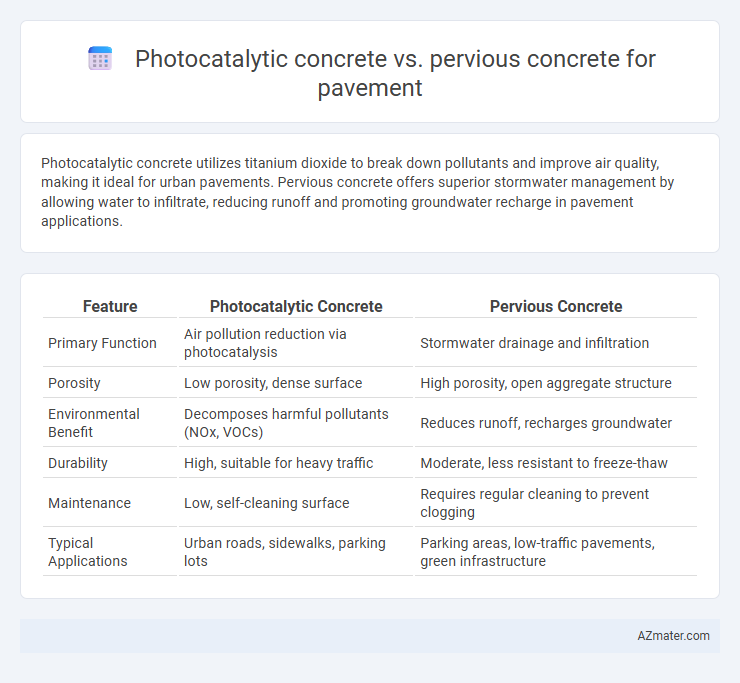Photocatalytic concrete utilizes titanium dioxide to break down pollutants and improve air quality, making it ideal for urban pavements. Pervious concrete offers superior stormwater management by allowing water to infiltrate, reducing runoff and promoting groundwater recharge in pavement applications.
Table of Comparison
| Feature | Photocatalytic Concrete | Pervious Concrete |
|---|---|---|
| Primary Function | Air pollution reduction via photocatalysis | Stormwater drainage and infiltration |
| Porosity | Low porosity, dense surface | High porosity, open aggregate structure |
| Environmental Benefit | Decomposes harmful pollutants (NOx, VOCs) | Reduces runoff, recharges groundwater |
| Durability | High, suitable for heavy traffic | Moderate, less resistant to freeze-thaw |
| Maintenance | Low, self-cleaning surface | Requires regular cleaning to prevent clogging |
| Typical Applications | Urban roads, sidewalks, parking lots | Parking areas, low-traffic pavements, green infrastructure |
Introduction to Innovative Pavement Materials
Photocatalytic concrete incorporates titanium dioxide, enabling the breakdown of pollutants such as nitrogen oxides, enhancing urban air quality through photocatalytic reactions activated by sunlight. Pervious concrete features a porous structure that facilitates stormwater infiltration, reducing runoff and promoting groundwater recharge, which aids in effective water management for pavements. Both innovative pavement materials address environmental challenges by integrating air purification and sustainable drainage solutions into urban infrastructure design.
Understanding Photocatalytic Concrete
Photocatalytic concrete incorporates titanium dioxide (TiO2), which activates under sunlight to break down pollutants such as nitrogen oxides (NOx), improving urban air quality. This innovative material enhances the environmental performance of pavements by reducing harmful emissions while maintaining durability. Compared to pervious concrete, which primarily focuses on water permeability and stormwater management, photocatalytic concrete targets air purification, offering a complementary solution for sustainable pavement design.
Overview of Pervious Concrete
Pervious concrete is a highly porous material designed to allow water to pass through its surface, significantly reducing stormwater runoff and promoting groundwater recharge. Its unique structure enhances pavement permeability, making it an effective solution for urban areas prone to flooding and heavy rainfall. This concrete type supports sustainable water management by filtering pollutants and improving overall environmental quality in pavement applications.
Comparative Environmental Benefits
Photocatalytic concrete significantly reduces air pollutants by breaking down nitrogen oxides (NOx) through titanium dioxide, enhancing urban air quality. Pervious concrete improves stormwater management by allowing water infiltration, reducing runoff and recharging groundwater supplies. Both materials contribute to sustainable pavement solutions, with photocatalytic concrete targeting air pollution control and pervious concrete addressing water conservation and urban flooding.
Air Purification and Water Management
Photocatalytic concrete leverages titanium dioxide to break down airborne pollutants, significantly improving urban air quality by reducing nitrogen oxides and volatile organic compounds. Pervious concrete enhances water management by allowing rainwater to infiltrate through its porous structure, reducing surface runoff and promoting groundwater recharge. Combining these materials in pavement design offers a synergistic approach to both air purification and sustainable stormwater management.
Structural Performance and Durability
Photocatalytic concrete enhances durability by integrating titanium dioxide particles that promote self-cleaning and pollution reduction without compromising compressive strength, making it suitable for urban pavements exposed to harsh environmental conditions. Pervious concrete offers excellent water permeability and stormwater management but typically exhibits lower compressive strength and higher susceptibility to freeze-thaw damage, necessitating careful mix design for structural performance. Both concretes demand tailored reinforcement and maintenance strategies to optimize longevity and load-bearing capacity in pavement applications.
Installation and Maintenance Considerations
Photocatalytic concrete requires specialized installation techniques to evenly distribute titanium dioxide coatings for optimal pollutant decomposition, while pervious concrete demands careful mix design and compaction to maintain high permeability and structural integrity. Maintenance for photocatalytic concrete involves periodic cleaning to preserve surface reactivity, whereas pervious concrete requires regular vacuuming or pressure washing to prevent clogging and sustain infiltration capacity. Both types demand attention to environmental conditions during installation to ensure long-term performance in pavement applications.
Cost Analysis and Economic Impact
Photocatalytic concrete incorporates titanium dioxide to reduce air pollutants, resulting in higher initial material and production costs compared to pervious concrete, which prioritizes stormwater management through its porous structure. Pervious concrete offers lower upfront expenses and reduced runoff-related infrastructure costs, yet may incur additional maintenance due to clogging risks. The economic impact of photocatalytic concrete includes potential public health savings from improved air quality, while pervious concrete primarily contributes to urban flood mitigation and groundwater recharge savings.
Real-World Applications and Case Studies
Photocatalytic concrete utilizes titanium dioxide to reduce air pollutants, demonstrated in urban areas of Milan and Tokyo where it significantly decreases nitrogen oxide levels. Pervious concrete improves stormwater management by allowing water infiltration, as seen in Portland and Seattle projects that reduce runoff and recharge groundwater. Both materials enhance pavement sustainability, with photocatalytic concrete targeting air quality improvement and pervious concrete addressing water management challenges.
Choosing the Right Concrete for Sustainable Pavements
Photocatalytic concrete enhances air quality by breaking down pollutants through its titanium dioxide content, making it ideal for urban environments seeking to reduce vehicular emissions and improve sustainability. Pervious concrete, designed for effective stormwater management, promotes groundwater recharge and reduces runoff, addressing urban flooding and improving water quality in pavement systems. Choosing the right concrete depends on specific environmental goals--air pollution reduction favors photocatalytic concrete, while managing stormwater and preventing flooding prioritizes pervious concrete for sustainable pavements.

Infographic: Photocatalytic concrete vs Pervious concrete for Pavement
 azmater.com
azmater.com